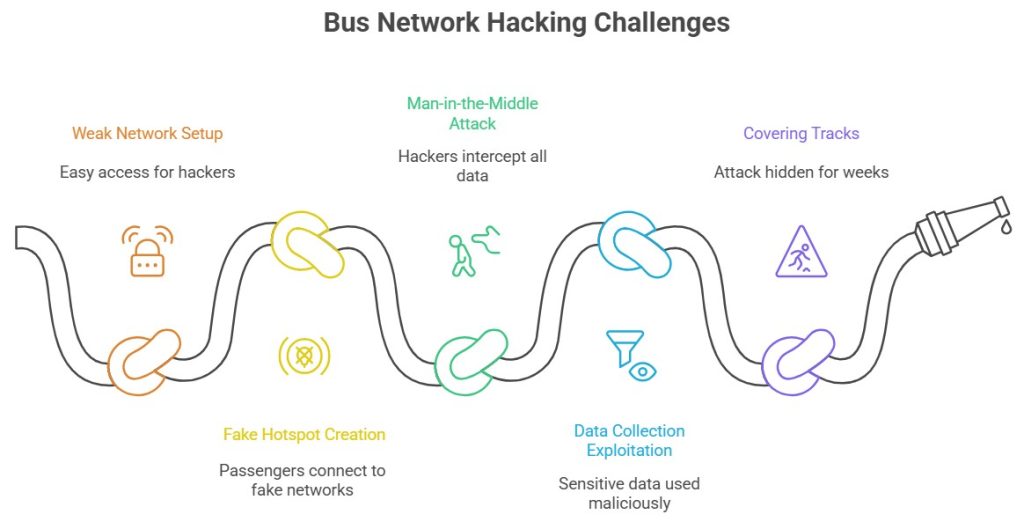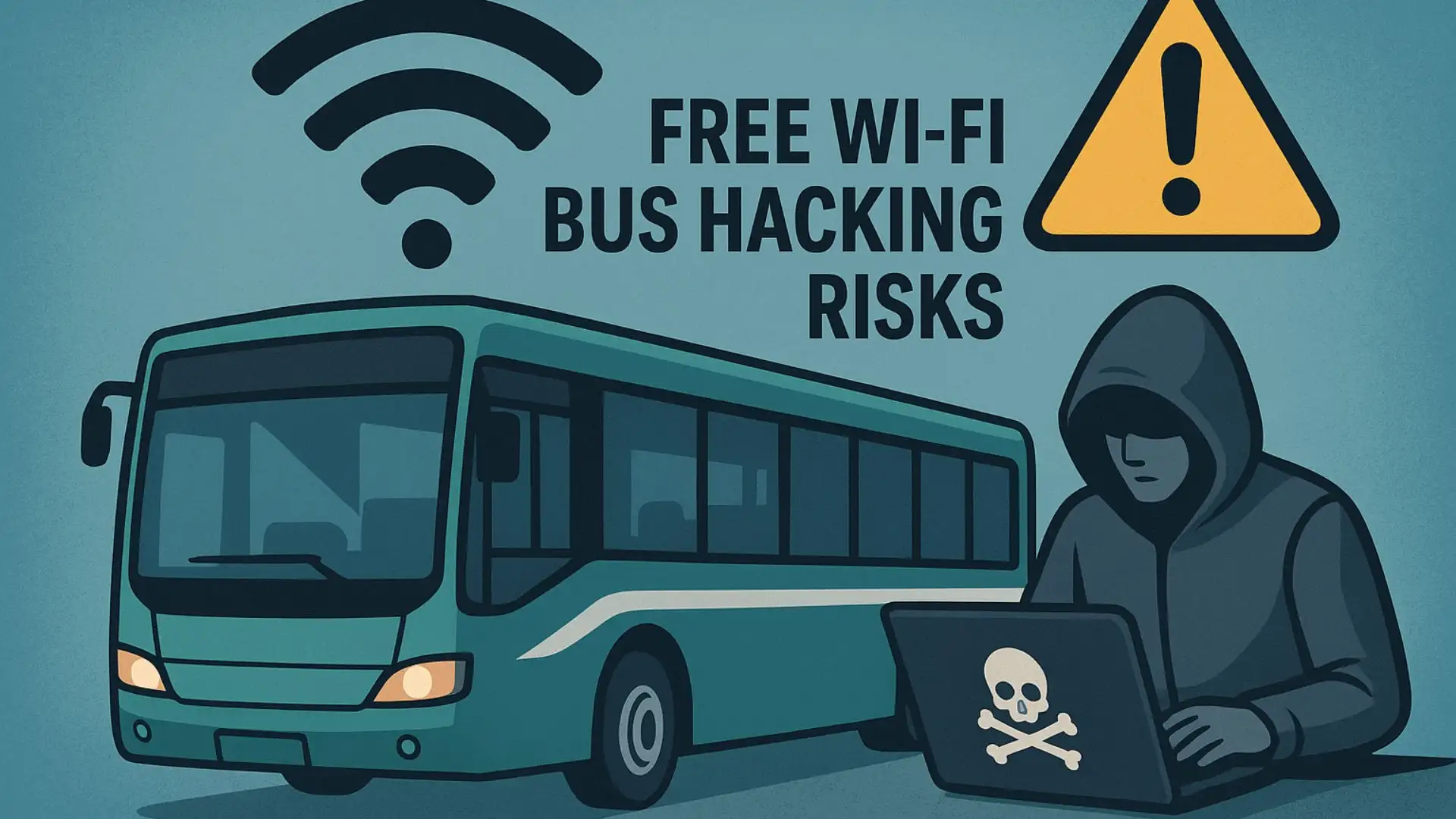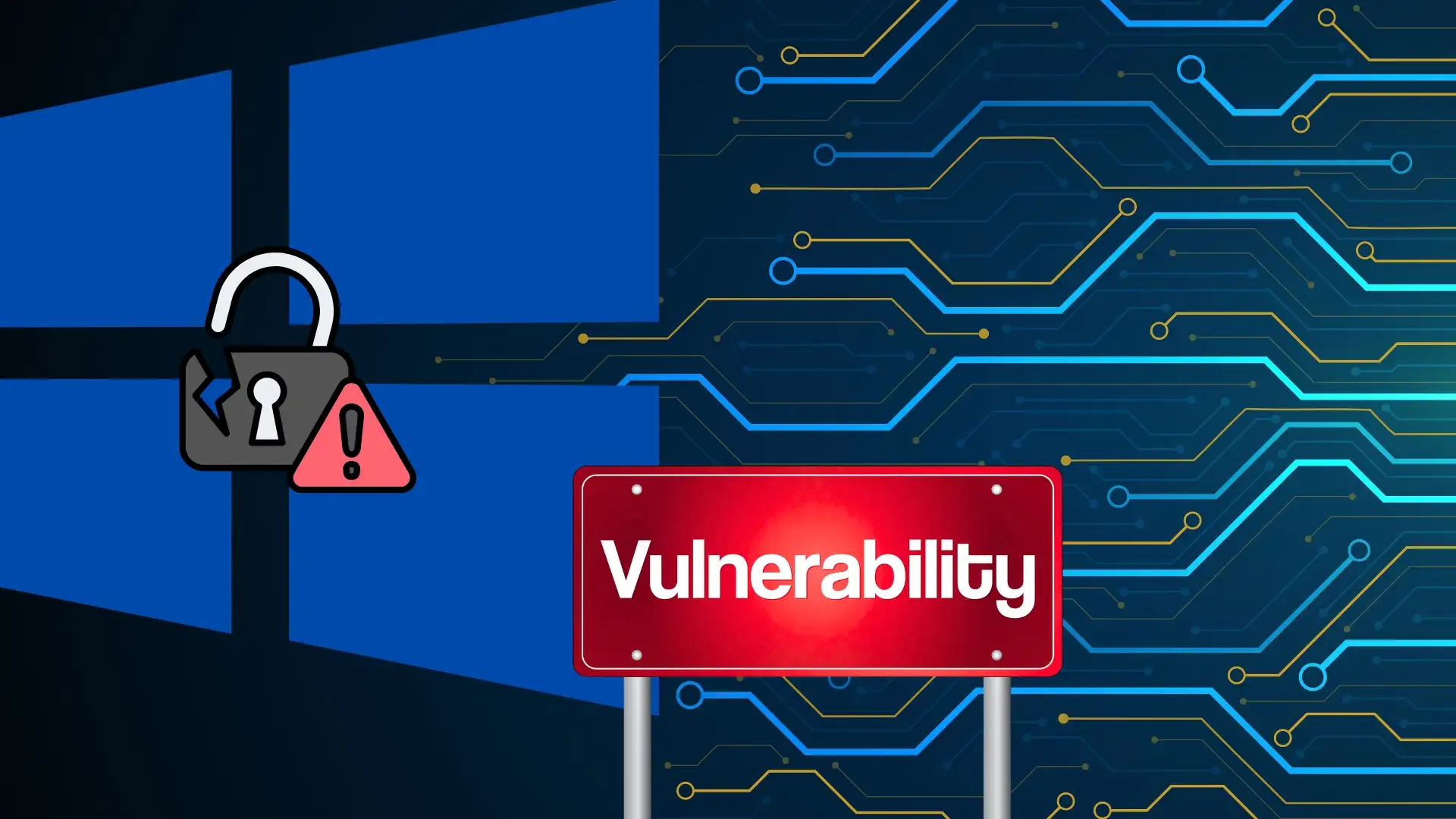Imagine you are sitting on a crowded city bus, tapping away on your phone, connected to the bus’s free Wi-Fi. It feels safe and easy. But what if I tell you that hackers could be watching every move you make online? That this simple connection might have let criminals into your private world? This is not just a story; it is a reality that happened recently, and it is one of the clearest examples of the free Wi-Fi bus hacking risks we all face. Let me tell you exactly what happened, how it happened, who was behind it, and what you need to do to protect yourself.
What Actually Happened? The Incident in Simple Terms
A major city’s public transport system offered free Wi-Fi on many of its buses, attracting thousands of daily users. At first glance, this seemed like a great service. But behind the scenes, a group of hackers found a way to exploit the weak security in the bus Wi-Fi network. Over several weeks, they secretly intercepted the data being shared by passengers. This included emails, social media logins, and even some financial transactions.
Passengers began to notice strange activity such as accounts being hacked, unauthorized transactions, and personal information leaks. Authorities started investigating and discovered the attack had been ongoing, quietly siphoning data from hundreds of connected users. This incident exposed how dangerous free Wi-Fi bus hacking risks can be when networks lack proper security.
How Did It Happen? Let Me Walk You Through the Workflow. Step by Step
This is where it gets technical, but I’ll explain it clearly, step by step. Imagine this like a secret operation by the hackers.
- Weak Network Setup: The bus Wi-Fi was open or used weak encryption, making it easy for anyone to connect without needing strong authentication. The first mistake was the network’s poor security design.
- Fake Hotspot Creation: Hackers set up fake Wi-Fi access points mimicking the official bus network’s name. When passengers unknowingly connected to these fake hotspots, the hackers gained a direct line into their devices.
- Man-in-the-Middle Attack (MitM): Once connected, the hackers placed themselves between the passenger’s device and the internet. This allowed them to capture all data sent and received, including passwords and messages, without users knowing.
- Data Collection and Exploitation: The hackers collected this sensitive data in real time. They then used it for identity theft, financial fraud, and selling personal information on the dark web.
- Covering Their Tracks: The group used advanced methods to avoid detection by the bus company’s network monitoring tools, keeping the attack hidden for weeks.

What made this attack so effective was the combination of a poorly secured public Wi-Fi network and passengers’ trust in a free service. Users had no idea their information was being stolen while they browsed or worked on their devices. This is a classic example of free Wi-Fi bus hacking risks playing out in real life.
Who Was Behind the Attack? Let Me Tell You What’s Known
This was not the work of a lone hacker. Investigations revealed a cybercrime group operating from abroad was behind the attack. This gang is known for targeting public Wi-Fi networks in major cities worldwide. They specialize in creating fake hotspots and using man-in-the-middle techniques to steal data silently.
The group consists of several people:
- Technical Experts: They set up the fake networks and handle the interception of data.
- Data Processors: These members analyze the stolen information and look for valuable targets.
- Fraudsters: They use the data to commit identity theft and financial crimes.
- Money Launderers: This group moves the stolen money and profits through complex channels to avoid detection.
This gang has been active for years, targeting public transport systems, cafes, and airports, where people connect to free Wi-Fi without much thought. This highlights how widespread free Wi-Fi bus hacking risks have become.
The incident also showed links to other cybercrime activities, including ransomware attacks and phishing campaigns. Law enforcement agencies are now working internationally to track down the full gang.
Consequences and Financial Impact
The financial loss from this single free Wi-Fi bus hacking incident was huge. Authorities estimate the total loss to be in the millions. Passengers lost money from hacked bank accounts, suffered identity theft, and faced emotional distress from stolen personal information. Many people had to spend hours and sometimes days fixing the damage.
For the city, the incident damaged public trust. People became wary of using the free Wi-Fi service, hurting the transport company’s reputation. Media outlets reported extensively, raising public awareness about the dangers of unsecured Wi-Fi. Politicians demanded investigations and called for stronger cybersecurity laws.
Socially, it was a wake-up call. People realized that convenient, free Wi-Fi can carry hidden risks that impact not just individual users but the whole community. For journalists, this incident was a headline example of modern cybercrime’s reach and a clear warning about free Wi-Fi bus hacking risks.
How Can You Be Attacked by Such a Hack? And how can you detect it?
If you use free Wi-Fi on a bus or in any public place, here’s how hackers might attack you:
- You connect to a fake or unsecure hotspot.
- The hacker intercepts your traffic, capturing passwords or sensitive info.
- Your online accounts get accessed without your permission.
- Malware might be installed silently on your device.
How do you know if you have been attacked?
- Unexpected password reset emails.
- Unusual charges on your bank or credit card.
- Your friends telling you they got suspicious messages from your account.
- Your device is behaving strangely with slowdowns, pop-ups, or unknown apps.
If you notice these signs, disconnect from the Wi-Fi immediately and take action to secure your accounts. This way, you reduce the impact of free Wi-Fi bus hacking risks.
How to Protect Yourself from Free Wi-Fi Bus Hacking Risks
Listen closely because this is the most important part. Using free Wi-Fi on buses can put your personal information at risk, but you can protect yourself by following a few simple steps.
Always Check the Wi-Fi Network Name: Before you connect, make sure the network name is the real one. Hackers often create fake Wi-Fi names that look very similar to the official network. Ask the bus staff or look for signs to confirm the correct name. Connecting to the wrong network can give hackers access to your data.
Use a Virtual Private Network (VPN): A VPN creates a private, secure tunnel for your data when you use public Wi-Fi. It scrambles your information so hackers cannot read it. Using a good VPN is one of the best ways to defend yourself against free Wi-Fi bus hacking risks.
Avoid Logging Into Sensitive Accounts: Try not to access your bank, work email, or any site that has your payment details when on public Wi-Fi. Waiting to log into these accounts until you are on a secure, private network lowers your chances of being hacked.
Keep Your Device Updated: Your device updates include important security fixes. Hackers look for devices with old software because they are easier to attack. Always install updates for your operating system and apps to close security gaps.
Turn Off Sharing Features: Disable file sharing, AirDrop, or any setting that allows others to connect to your device when using public Wi-Fi. This keeps your device hidden from other users on the network and lowers the risk of attack.
Use websites with HTTPS: Check that websites you visit use HTTPS. This means the site encrypts data between you and the website. Avoid entering passwords or personal info on sites without HTTPS to reduce risks.
Enable Firewall and Use Antivirus Software: Turn on your device’s firewall to block unwanted access attempts. Also, use antivirus software to detect and stop malware. Both tools help protect you from threats on free Wi-Fi networks.
Disconnect When Not in Use: Do not stay connected to public Wi-Fi when you are not using it. Some apps run in the background and send data, which can be intercepted. Disconnecting reduces your exposure to free Wi-Fi bus hacking risks.
Preparing yourself means understanding these risks. Study basic cybersecurity practices. Learn to spot suspicious Wi-Fi networks and know how to use protection tools like VPNs. Stay alert every time you connect to free Wi-Fi, especially on buses or public transport. These steps will significantly reduce your chances of falling victim to free Wi-Fi bus hacking risks.

Lessons Learned from Free Wi-Fi Bus Hacking Risks: What This Incident Teaches Us All
This incident showed how easy it is to fall into the trap of free Wi-Fi bus hacking risks if we are careless. The biggest lesson is simple: convenience should never come at the cost of security. Protecting yourself starts with awareness and smart habits.
Real life teaches us that hackers are always looking for weak points. Public Wi-Fi is a prime target. By educating ourselves and others, we can reduce the chances of falling victim.
Let me break it down for you:
- Never trust any free Wi-Fi blindly.
- Always use extra security layers like VPNs.
- Update your devices regularly.
- Be suspicious of networks with generic or duplicate names.
- Monitor your accounts for strange activity.
In the end, cybersecurity is a shared responsibility. This is where experts like Hoplon Infosec come in. They work to protect public networks, educate users, and develop tools to fight cybercrime. If we all stay informed and cautious, we can enjoy the benefits of technology without falling prey to hackers or free Wi-Fi bus hacking risks.
Summary: How to Stay Safe From Free Wi-Fi Bus Hacking Risks
- Verify official network names before connecting.
- Use a VPN for encryption.
- Avoid accessing sensitive accounts on public Wi-Fi.
- Keep device software and antivirus updated.
- Disable file sharing and other sharing options.
- Use HTTPS websites.
- Disconnect when not actively using Wi-Fi.
- Monitor your accounts for unusual activity.
Following these steps will help keep your data safe when using free Wi-Fi on buses. Remember, your security depends on your actions as much as technology. Stay alert, stay safe, and do not let free Wi-Fi bus hacking risks ruin your digital life.






